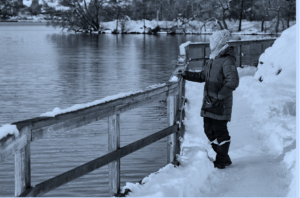Photo by Pexels
4 Ways to Cope with Seasonal Affective Disorder This Winter
by Kimberly Hayes
Do you find yourself dealing with depression each year during the colder months? Most people write this plummeting mood off as “the winter blues,” but you could actually be experiencing something more serious than that. You could be dealing with seasonal affective disorder, also called SAD. Thought to be caused by a reduction in exposure to sunlight, SAD is a type of major depression marked by feeling recurring lows during the winter.
With SAD you may experience:
- Lethargy and low energy
- Lack of enjoyment in activities where you usually find fun
- Sleep changes — either too much or too little.
- Heaviness in the arms and legs
- Trouble with motivation, concentration, and focus.
- Irritability or social sensitivity.
- Changes in appetite that can lead to drastic weight loss or gain.
Here are a few steps you can take to manage your symptoms of seasonal affective disorder to improve your mood and increase your energy during the winter.
Focus on Your Gut
The health of your gut impacts much more than digestion. You should start by focusing on wholesome, nutritious, seasonal foods. However, for people dealing with SAD, diet alone may not be enough to help combat the lethargy and sadness. Taking supplements like probiotics that transplant healthy bacteria into your gut is a good, basic step for dealing with SAD. Improved gut health can lead to happier, stress-free and energized winter days.
Write it out
While you may feel too adult for a “Dear Diary” type of journal, daily writing is shown to have a profound impact on your mood. You can start with a gratitude journal, where you start every day by filling at least a page with something you are thankful for. You can also look up journal writing prompts, reflect on a daily devotional, or focus on an aspiration. Want less structure? Try this exercise: Put on some music (preferably without words), close your eyes, and write without looking or thinking until the song is finished.
Explore EMDR
While known mainly as a treatment for symptoms of post-traumatic stress disorder (PTSD), Eye Movement Desensitization and Reprocessing (EMDR) therapy can relieve a lot of the same symptoms of SAD. During therapy sessions, you will take brief jaunts into distressing memories or events while a therapist directs your eyes to move side-to-side. This eye movement can stimulate your brain to resolve stuck or frozen emotional memories so you can be free from their emotional distress. How can this help with SAD? Working with a licensed therapist trained in EMDR, you can use EMDR to stop being triggered by specific situations that occur in the winter where you might feel overwhelmed, stressed, or depressed.
Get Outside
Yes, it is cold. Yes, it is dreary. No, that is not a good reason to stay inside. Even on chilly, overcast days, being outside can be a breath of fresh air for your mind and body. If you can, take it a step further and try to experience some nature. There is beauty in the stillness of leafless trees. There is serenity in the sun’s rays that play peek-a-boo through the clouds. Start small, such as taking a walk through your neighborhood or a nearby park. Just be sure to dress appropriately for the temperature. You can stay safe on snowy or icy sidewalks by putting simple traction cleats on your sneakers or boots.
When these symptoms hit you at the same time each year, you know you are dealing with a major type of depression and not just an occasional low. However, you do not have to suffer each year without relief. Try a few of these suggestions to help manage your symptoms. And, most importantly, talk to someone about the way you feel — your doctor, pastor, or a trusted counselor. You deserve to feel happy regardless of the season.



